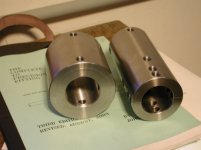Because you don't have the dimensions.
Doesn't seem that hard to figure it out from pictures or readily available references like John Hinnant's book, or Richard Franklin's video, especially if one has a receiver in the hand. Most of this tooling is really pretty simple to make if one is willing to spend some fun time in the shop and had a reasonably stocked metal archive. I sure couldn't see spending close to a grand to get tooled up so I'm making my own.
As far as the receiver truing tooling, the only real mandatory design data is available from measuring the bolt bore in the receiver and making sure the truing sleeve has a bore big enough to accept the receiver and some shims for padding and walls at least half an inch thick or so and wall thickness enough to avoid distortion when tightening the centering bolts.
A piece of half inch drill rod or presision ground shafting would make a removable mandrel to be used inside of bushings. Machine bushings to fit the bolt bore on each end, machine or ream the hole in the bushings to juuuuuuuuust slide on the drill rod and it should work just fine for aligning the receiver in a truing sleeve.
Based on what is done in the Franklin video I'd think a person could machine some inch long bushings with a slight taper, say .701 to .707 (or a couple of thou under to a couple of thou over the measured bolt bore for the receiver in question) over the length to get a snug fit in each end of the bolt bore. Machining them to fit might be best, but the taper will probably work nearly as well. I think Manson used to sell a mandrel with tapered bushings but I may be wrong about that.
The receiver truing sleeve isn't that hard to make either. It's a couple hours work if one has a chunk of metal, lathe, and drill press or mill available. A 6" long 3" to 3.5" diameter rod end is all that's needed.
There are a at least three versions of them out there, maybe more. When I asked him in an e-mail what size the one he uses in his video is (I have it - very informative and only twenty four bux including shipping), Richard Franklin very helpfully wrote back that the one he uses in his video is 3-1/2" OD with 3/4" thick walls and about 3-1/2" long. I made one of those and another one 3" OD, 1-5/8" ID, 6-1/2" long with two sets of centering screws on one end for long and short actions. I'd never made one before but it wasn't that hard. As I recall, Richard also uses a mandrel with tapered bushings.
I haven't made the mandrel and tapered bushings yet, the holiday sort of got in the way, but a half inch drill rod mandrel and bushings will be in work here shortly.
If one just wanted to machine the receiver face, a mandrel like that in John Hinnant's book would work fine, at least it works for him. Another excellent source of tooling information. John has drawings for enough tooling to do the whole job in that book he published.
Fitch


